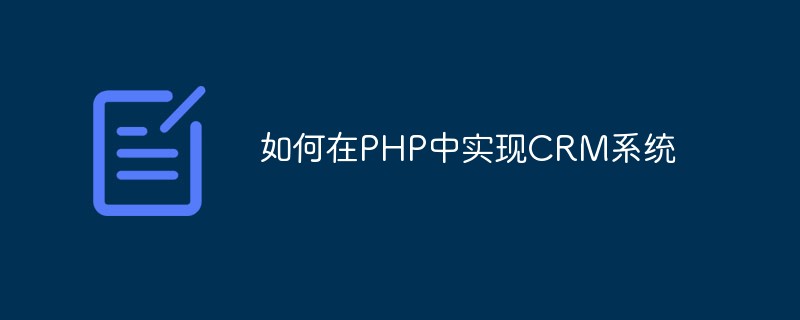 Backend Development
Backend Development PHP Tutorial
PHP Tutorial PHP mall development guide to implement order management function
PHP mall development guide to implement order management functionPHP Mall Development Guide to Implement Order Management Function
- Introduction
With the rapid development of e-commerce, many companies have begun to transform online sales and establish their own E-mall. Order management is a basic and crucial function, which involves a series of processes such as order creation, payment, distribution and after-sales. This article will introduce how to implement order management functions through PHP development and provide corresponding code examples.
- Building the system environment
First of all, it is essential to build a PHP development environment. We can choose to use an integrated development environment (IDE) such as XAMPP or WAMP, or we can install a combination of Apache, MySQL and PHP ourselves. After ensuring that the environment is set up, we can start writing code.
- Database design
The order management function requires a database to store order-related data. The following is a simple database design example:
Orders table (orders):
- order_id (order ID)
- customer_id (customer ID)
- amount (order amount)
- status (order status)
- created_at (order time)
- updated_at (updated time)
Order details table (order_details):
- order_id (order ID)
- product_id (product ID)
- quantity (quantity)
Customer table (customers):
- customer_id (customer ID)
- name (customer name)
- email (customer email)
Product table (products):
- product_id (product ID)
- name (product name)
- price (product price)
You can adjust the database structure according to actual needs.
- Order management function implementation
4.1 Creating an order
When a user places an order, we need to create a new order. In PHP, we can use MySQL's INSERT statement to achieve this.
// 获取用户选择的产品ID和数量 $product_id = $_POST['product_id']; $quantity = $_POST['quantity']; // 计算订单金额 $query = "SELECT price FROM products WHERE product_id = $product_id"; $result = mysqli_query($connection, $query); $row = mysqli_fetch_assoc($result); $price = $row['price']; $amount = $price * $quantity; // 创建订单 $query = "INSERT INTO orders (customer_id, amount, status, created_at) VALUES ($customer_id, $amount, '待支付', NOW())"; mysqli_query($connection, $query); $order_id = mysqli_insert_id($connection); // 添加订单详情 $query = "INSERT INTO order_details (order_id, product_id, quantity) VALUES ($order_id, $product_id, $quantity)"; mysqli_query($connection, $query);
4.2 Order payment
When the user makes a payment, we need to update the status of the order to "paid".
// 获取订单ID $order_id = $_POST['order_id']; // 更新订单状态 $query = "UPDATE orders SET status = '已支付' WHERE order_id = $order_id"; mysqli_query($connection, $query);
4.3 Order Delivery
After the order payment is completed, we need to perform the order delivery operation. Here we can notify customers of order delivery information via email, text message, or in-site message.
// 获取订单ID
$order_id = $_POST['order_id'];
// 获取客户邮箱
$query = "SELECT email FROM customers WHERE customer_id = (SELECT customer_id FROM orders WHERE order_id = $order_id)";
$result = mysqli_query($connection, $query);
$row = mysqli_fetch_assoc($result);
$email = $row['email'];
// 发送订单配送信息到客户邮箱
$mail = new PHPMailer();
$mail->setFrom('admin@example.com', 'Admin');
$mail->addAddress($email);
$mail->Subject = '订单配送信息';
$mail->Body = '您的订单已经发货,请注意查收。';
$mail->send();4.4 Order after-sales
In some cases, customers may need to perform after-sales operations, such as refunds, exchanges, etc. We can provide an after-sales management interface to allow customers to submit after-sales applications.
// 获取售后申请信息 $order_id = $_POST['order_id']; $reason = $_POST['reason']; // 创建售后申请 $query = "INSERT INTO aftersales (order_id, reason, created_at) VALUES ($order_id, '$reason', NOW())"; mysqli_query($connection, $query);
- Summary
This article introduces how to use PHP development to implement order management functions, including order creation, payment, distribution and after-sales, etc. Through the above sample code, you can quickly build a fully functional e-mall system and manage orders. Of course, this is just a simple example, and you can adjust the code and extend the functionality according to actual needs. I hope this article can be helpful to your order management in mall development.
The above is the detailed content of PHP mall development guide to implement order management function. For more information, please follow other related articles on the PHP Chinese website!
 如何在PHP中实现SEO优化May 20, 2023 pm 01:30 PM
如何在PHP中实现SEO优化May 20, 2023 pm 01:30 PM随着互联网的发展,SEO(SearchEngineOptimization,搜索引擎优化)已经成为了网站优化的重要一环。如果您想要使您的PHP网站在搜索引擎中获得更高的排名,就需要对SEO的内容有一定的了解了。本文将会介绍如何在PHP中实现SEO优化,内容包括网站结构优化、网页内容优化、外部链接优化,以及其他相关的优化技巧。一、网站结构优化网站结构对于S
 如何在PHP中实现ERP系统May 20, 2023 pm 06:21 PM
如何在PHP中实现ERP系统May 20, 2023 pm 06:21 PM随着电子商务和企业管理的发展,许多企业开始寻找更好的方法来处理其日常业务流程。ERP系统是一种能够整合企业各种业务流程的软件工具。它提供了全面的功能,包括生产、销售、采购、库存、财务等方面,帮助企业提高效率、控制成本和提高客户满意度。而在PHP编程语言中,也能够实现ERP系统,这就需要我们掌握一些基本的知识和技术。下面,我们将深入探讨如何在PHP中实现ERP
 在PHP中如何实现物联网开发?May 12, 2023 am 11:51 AM
在PHP中如何实现物联网开发?May 12, 2023 am 11:51 AM随着物联网技术的发展和普及,越来越多的应用场景需要使用PHP语言进行物联网开发。PHP作为一种广泛应用于Web开发的脚本语言,它的易学易用、开发速度快、可扩展性强等特点,使其成为开发物联网应用的一种优秀选择。本文将介绍在PHP中实现物联网开发的常用技术和方法。一、传输协议和数据格式物联网设备通常使用TCP/IP或UDP协议进行数据传输,而HTTP协议是一个优
 如何在PHP中实现CRM系统May 20, 2023 pm 12:31 PM
如何在PHP中实现CRM系统May 20, 2023 pm 12:31 PM随着企业的发展,客户管理变得越来越重要。为了提高客户满意度和忠诚度,越来越多的企业采用客户关系管理系统(CRM)来帮助其管理客户关系。而PHP是一种流行的编程语言,因其简单易学、灵活和强大而被广泛应用于Web开发。那么,如何在PHP中实现CRM系统呢?本文将为您介绍实现CRM系统的步骤和技巧。Step1:需求分析在开始开发CRM系统之前,您需要进行需求分析
 如何在PHP中实现轮播图May 22, 2023 am 08:25 AM
如何在PHP中实现轮播图May 22, 2023 am 08:25 AM随着互联网的发展,轮播图已经成为了网页设计中必不可少的一部分。在很多网页中,轮播图经常被用作展示企业文化、最新产品或是推广活动等场景。本篇文章将会分享如何使用PHP来实现轮播图的功能。一、轮播图的概念轮播图是网页中一种常见的视觉效果,一般由多个图片组成,在页面中自动或手动进行切换,展示多个内容。可以添加符合业务要求的动画效果,有助于引起用户的关注和提高网站的
 如何在PHP中实现验证码May 20, 2023 am 11:31 AM
如何在PHP中实现验证码May 20, 2023 am 11:31 AM随着互联网的不断发展,越来越多的网站需要使用验证码来保证安全性。验证码是一种借助人类能力而无法被计算机破解的认证技术,广泛应用于网站注册、登录、找回密码等功能中。下面将介绍如何使用PHP实现验证码功能。一、生成验证码图片验证码图片的生成是验证码功能的核心,需要生成一个随机字符,并将其渲染为图像展示给用户。在PHP中,可以使用GD库来生成图片。GD库是一种用于
 在PHP中如何实现智能合约?May 12, 2023 am 08:09 AM
在PHP中如何实现智能合约?May 12, 2023 am 08:09 AM智能合约(SmartContract)是一种基于区块链的自动化交易程序,可以实现自动化执行、验证和执行交易。智能合约可以减少交易中的人为干扰,提高交易的安全性和效率。在不同的区块链中,智能合约的实现方式略有不同。本文将介绍在PHP中如何实现智能合约。PHP是一种广泛使用的编程语言,特别适合Web开发。PHP有着成熟的开源生态系统,以及许多可靠的框架和库。在
 在PHP中如何实现OA开发?May 12, 2023 am 08:36 AM
在PHP中如何实现OA开发?May 12, 2023 am 08:36 AM随着现代企业管理的需求与时俱进,各种管理软件如ERP、CRM、HRM和OA等软件的使用已经变得越来越普遍。特别是办公自动化(OA)软件,已经成为企业必不可少的一部分。随着PHP发展的越来越成熟,越来越多的企业开始使用PHP作为开发OA软件的工具,并取得了很好的效果。那么,在PHP中如何实现OA开发呢?确定OA的需求在开始OA的开发之前,必须先明确自己的OA需


Hot AI Tools

Undresser.AI Undress
AI-powered app for creating realistic nude photos

AI Clothes Remover
Online AI tool for removing clothes from photos.

Undress AI Tool
Undress images for free

Clothoff.io
AI clothes remover

AI Hentai Generator
Generate AI Hentai for free.

Hot Article

Hot Tools

Dreamweaver CS6
Visual web development tools

Zend Studio 13.0.1
Powerful PHP integrated development environment

Safe Exam Browser
Safe Exam Browser is a secure browser environment for taking online exams securely. This software turns any computer into a secure workstation. It controls access to any utility and prevents students from using unauthorized resources.

SublimeText3 Mac version
God-level code editing software (SublimeText3)

Atom editor mac version download
The most popular open source editor





